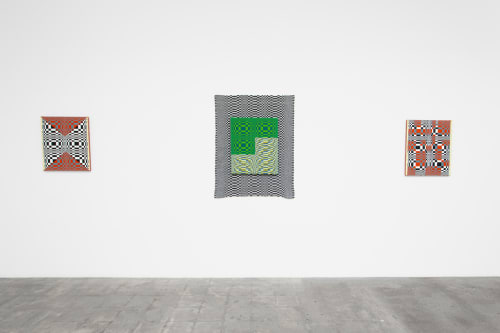Various Small Fires Los Angeles is pleased to announce the opening of a group show curated by Los Angeles-based textile artist Diedrick Brackens on August 12, 2023. The exhibition Shaping Color brings together six artists to explore the relationships between color and process in their respective practices. Many works in the exhibition are monochromes or utilize a restricted palette. Historically monochromes often signal an intent to emphasize mastery and skill; also, in parting with all information save the essential, artists attempt to access the ineffable and the spiritual.
FEATURED ARTISTS
Zalika Azim
Oliver Strand
Sarah Crowner
Samatha Bittman
Donald Moffett
Bakari Akinyele
"With monochrome painting... the idiosyncrasy of the work, its difference, its expression lies in shape." – Guido Molinari
The exhibition Shaping Color, conceived by LA-based textile artist Diedrick Brackens, brings together six artists to explore the relationships between color and process in their respective practices. Many works in the exhibition are monochromes or utilize a restricted palette. Historically monochromes often signal an intent to emphasize mastery and skill; also, in parting with all information save the essential, artists attempt to access the ineffable and the spiritual.
Color, as employed by these makers, is intrinsically tied to their mediums and modes of production. Color becomes an agent of transmutation, not just a mere surface or mask for form; these objects are altered in ways that inform their subjects radically and color is treated as material rather than surface or ornamentation.
Donald Moffett’s Lot 080820 (open red), 2020, was a starting point for the exhibition, a wide waiting throat, a silent utterance, a moan of grief or dizzying pleasure. Moffett has been making these monochromes for many years. Using lacquer and resin to literally shape his objects, Moffett makes color material rather than surface. His paintings are often filled with openings and shaped in ways that suggest bodies and their orifices, and often they signify queer architecture. He has managed to distill riotous queer bodies into these shaped works.
Zalika Azim is an Afro-Caribbean/American multimedia artist and photographer. In a recent series of photographs, Azim uses the color black to describe the experience of J’ouvert, a processional tradition of Trinidad where participants paint their bodies in concoctions of paint, oil, and other pigments derived from the earth, disguising the individual and collectivizing the group. While photographing these performances, Azim intervenes in the photographic process and causes the resulting images to darken, obscuring her subjects. She couples masking and veneration, disrupting the photographic impulse to present and document.
More than half of the artists in the exhibition turn toward craft practices like sewing, dyeing, weaving, and woodworking. Samantha Bittman and Sarah Crowner specifically evoke the histories of abstraction, OpArt, and studio craft. The intersection of painting and textiles in their respective practices generates an exciting dialogue about matrices and what kind of looking is demanded of a viewer as their objects destabilize expectations and retrain the eye towards the haptic. These practices confront the discrepancies between the painting, design, and textile work long established in the hierarchy of art discourse while re-enlivening abstraction and modernist aesthetics.
Extending this conversation around craft, Bakari Akinyele’s use of cloth-dying techniques inspired by batik, shibori, and other traditional forms of pattern-based dying, reminds the viewer of the blurred boundaries between craft, art, and everyday life. Similarly, Oliver Strand, a musician and woodworker based in Massachusetts applies an attention to constructing everyday objects, particularly chairs, with an eye toward creating heirlooms who’s forms and finishes will both withstand heavy use and age and evolve through interaction with their owners. The chair in Shaping Color has a translucent black wash coat painted over a deep red. This layering allows the red to shine through, emphasizing the chair’s hand-carved surfaces. Over many years the black will wear away and more and more of the red will shine through, creating a kind of aura or halo around the sitter’s body. This use of color is an older convention and goes back to American Windsor chairs that survive from the mid-1700s.


